Hollywood Mask
In 1935, the French magazine ‘Votre Beauté’ ran a story on the Masque d’Hollywood, a new peeling mask from the Insitut Anne-Natalie Ouvry, a beauty salon situated at 11 Rue Montaigne, Paris. The publicity it received, its catchy name, and its claim to be a rejuvenation technique used by American film stars, created more interest in this mask than similar masks introduced in France in the 1930s, some arriving earlier than the Masque d’Hollywood.
Parisian interest in the Masque d’Hollywood and its associated cosmetics enabled Ouvry to move her Paris salon to 11 Rue Jean-Mermoz, open a Bar de Beauté at 8 Rue Royal and establish a London salon across the Channel at 16 Brook Street in fashionable Mayfair.
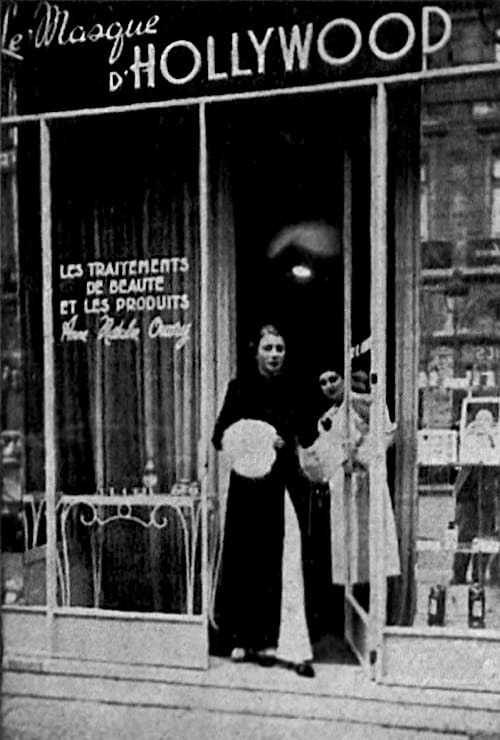
Above: 1938 Anne-Natalie Ouvry salon with Masque d’Hollywood emblazoned its name across the top of the shop frontage.
To help expand her business, Ouvry and her partner(s) established a new company – Le Masque d’Hollywood S.A. (capital ₣50,000) – in Paris in 1938 and they also trademarked the name Masque d’Hollywood in that year as well. Unfortunately for Ouvry, growth in her business was halted when the Second World War broke out in 1939.
Source
The Masque d’Hollywood may have been sourced from the American company, Uthagen Laboratories, founded by Dr. Jesse Ray Kirby in Hollywood, California in 1931. Like the Masque d’Hollywood, the Uthagen Flexible Mask was applied warm, allowed to set and then removed in one piece. The Uthagen mask also predates any of the French masks and is the earliest record I have for a mask of this type.
If Uthagen Laboratories is the source of the mask then it is possible that other French salons also licensed the product from them. Laboratoire des Produits Jeunebal, Laboratoires Janning, and Madeleine Barbier all introduced peeling masks similar the Masque d’Hollywood in the 1930s but they did not received the same attention.
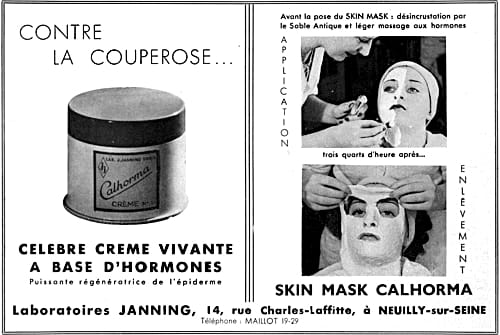
Above: 1937 Laboratoires Janning Skin Mask applied from a tube over Calhorma hormone cream.
Treatment
The Masque d’Hollywood treatment began with a facial cleanse. The mask came in a tube that was heated in a flask of hot water for five or six minutes to melt the ingredients. While the mask was being warmed a nourishing cream was massaged into the face with the excess removed with a tissue. The warm mask was then smoothed across the face with the fingers, a spatula or something similar, working from the forehead or around the eyes down to the chin, avoiding the eyelashes, eyebrows and lips. It was left on the face for 20 to 45 minutes then peeled off.

Above: 1935 Application steps for the Masque d’Hollywood (Votre Beauté, 1935). Top: Cleanse the face; heat the tube; and apply face cream. Middle: Remove excess cream; and apply mask. Bottom: Rest for a period; and then peel off the mask.
The nourishing cream was later replaced with a hormone cream and there are suggestions that Ouvry may have used a radium cream for a while. After the war, the cream was said to contain nutrients, vitamines, and hormones.
See also: Hormone Creams, Oils and Serums and Radioactive Cosmetics
The use of nutrient and/or hormone creams highlights the general ineffectiveness of this type of mask. They are not good absorbers like clay mask so would be ineffective on oily skin conditions and as they were applied over a cream they would not have acted as an exfoliator.
Like paraffin wax masks – which can also be removed in one piece – their main benefit came from the sealed-in perspiration induced by the warmth of the mask which ‘plumps up ’ the skin. Ouvry recommended the mask be as warm as possible to help with tis action. As the mask cooled it contracted, giving the impression that it was ‘bracing’ the face like an astringent. Both effects are short lived. Claims that the warmth ‘stimulated the circulation’ carrying away ‘waste matter that has been accumulating for years’ are highly speculative and could be applied to paraffin wax masks as well.
See also: Skin Tonics, Astringents and Toners, Clay Masks, and Paraffin Wax Treatments
Adding all this together, their main attraction of masks of this type appears to have been their novelty combined with the possible psychological impression that all skin problems are being ‘peeled off’.
Composition
The exact composition of the Masque d’Hollywood is unknown to me. Peeling masks first appeared in Beauty Culture in the 1930s and Deakers (1936) suggests that most were gum masks. He recommended using gum acacia (arabic) to form the film but masks like this were washed off, not peeled off, so the Masque d’Hollywood is not off this type.
Wells and Lubowe (1964) describe a mask favoured by beauty salons that used tragacanth and gelatin (2 to 2.5% of each) made into a solid gel by adding zinc oxide and glycerin. Like the Masque d’Hollywood it was melted before use in hot water and applied warm. However, de Navarre (1940) suggests that latex (rubber) was used in peeling masks of the period. In his regular ‘Desiderata’ column he writes:
Peeling Face Mask—A considerable number of people have asked for information on the composition of face masks sold in solid form, melted prior to use, applied to the face with a brush and allowed to dry. The mask upon drying is removed in one continuous piece. Such masks are based on rubber to which has been added some wax, emulsifier, gum such as tragacanth, zinc or titanium oxide and made into a emulsion. Usually latex emulsions are the source of the rubber. The product in essence is a sold emulsion of rubber, suitably stabilised with gum, and whitened with pigments.
(de Navarre, 1940, p.37)
These early peeling face masks gave way to newer formulations many based on plasticised polyvinyl alcohol (PVA), first used in the late 1950s. These masks had a long storage life, set quickly, come off cleanly and could have herbs or other materials incorporated into the formulation so were more than just barriers to evaporation. Other formulations followed, all enjoying the pleasing feeling a peeling mask can give.
First Posted: 6th April 2023
Sources
Deakers, T. W. (1936). Facial Masks. The Drug and cosmetic Industry, 4(38), 479-480.
de Navarre, M. G. (1940). Desiderata. American Perfumer & Essential Oil Review, 41(4), April, 36-37.
Le masque d’Hollywood. (1935). Votre Beauté, November, 27-29.
Wells, F. V., & Lubowe, I. I. (1964). Cosmetics and the skin. New York: Reinhold Publishing Corporation.

The Masque d’Hollywood as it appeared on the cover of ‘Votre Beauté’.
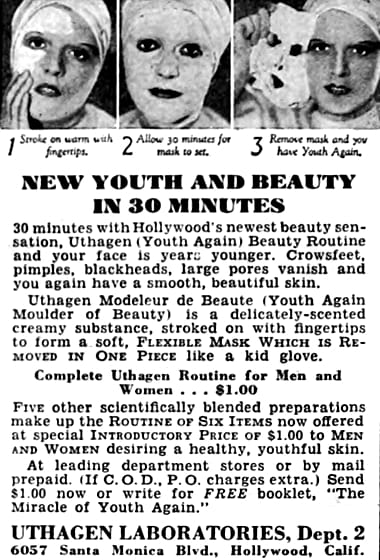
1932 Uthagen (Youth Again) Flexible Mask (USA).
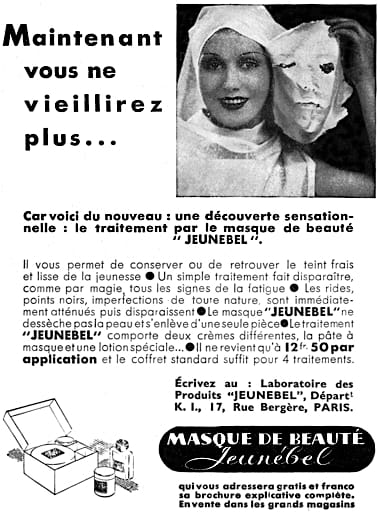
1933 Jeunebel Masque de Beauté.
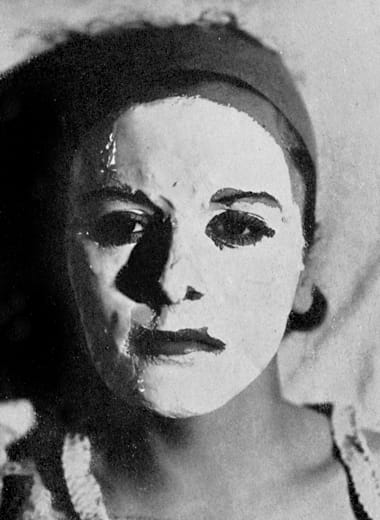
1935 Masque d’Hollywood.

1937 Madeleine Barbier Masque Unique.
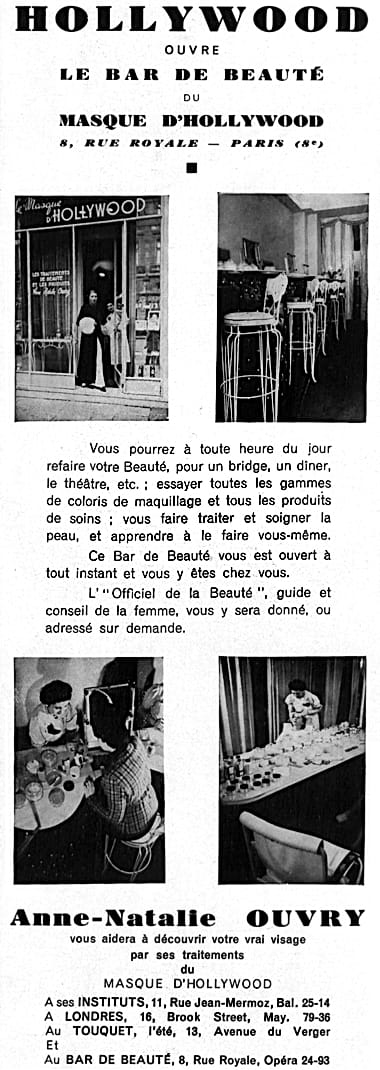
1938 Anne-Natalie Ouvry.
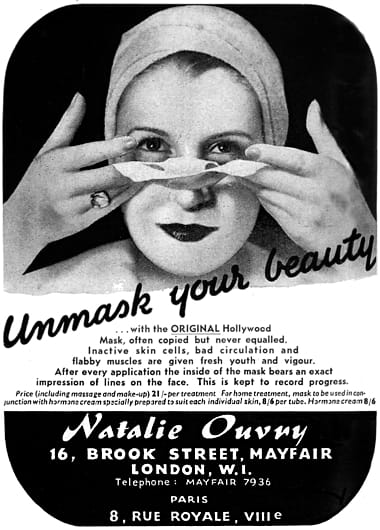
1938 Natalie Ouvry (London).
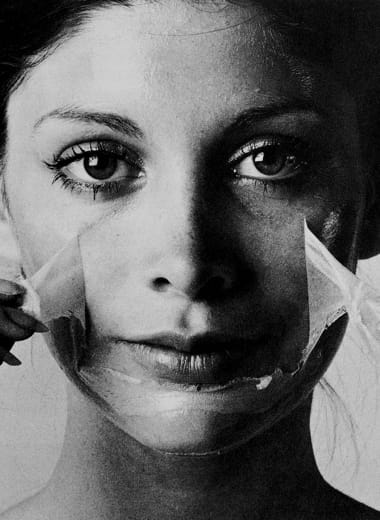
1970 Shiseido Facial Pack, a peel-off mask.
